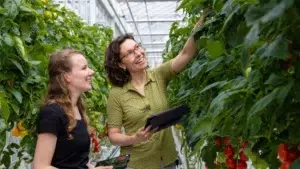What’s on the ASD Wish List?
As year one of alternative service delivery begins to wrap up, the focus turns to 2015. Germination looks into what could be in store for next year.
While 2014 marked a year of change for those involved in the seed industry, that change isn’t likely to come to a halt in 2015. The alternative service delivery program and the authorized seed crop inspection service will continue to evolve, meaning seed growers, inspectors and seed companies must be mentally prepared for more changes to the system.
“There were multiple service providers to choose from in most areas; for many crop kinds, there were new non-Canadian Food Inspection Agency inspectors in the field; and requests for inspections and inspection reports all moved to electronic formats,” says the Canadian Seed Trade Association’s CEO, Patty Townsend, summing up the changes that occurred in 2014. “Despite all of that, things seem to be going well.”
Alternative service delivery for seed crop inspections continues to evolve, with the possibility of other crops being added in 2015.
Dale Adolphe, executive director for the Canadian Seed Growers’ Association, agrees. “We anticipated there would be hiccups in the first year and that things would need tweaking with the rollout of an entirely new system,” Adolphe says. “Given the time frame we had to work within, I think everyone has done a tremendous job in 2014.”
In total, 270 inspectors were authorized with 24 service providers, and 89 per cent of the inspections were done through ASD, while CFIA did the remaining 11 per cent. Adolphe notes that CFIA’s target was for 75 per cent of the inspections to be done through ASD. “This means ASD was accepted and rolled out beyond our expectations and objectives,” he says. “That’s a positive sign.”
Assess and Evaluate
The Industry Government Working Group, which is comprised of CFIA, CSGA, CSTA and the Canadian Seed Institute, will be meeting in September to begin reviewing program feedback received to-date. For individuals who have comments, concerns or criticisms, be sure those are funnelled to the appropriate representing organization, which will carry those comments forward to the working group.
While it’s too early to say what changes to expect for next year because the 2014 season isn’t over — soybeans still need to come in — Adolphe says things will continue to progress and change.
For example, Adolphe says CSGA will be working to make access to information for inspectors more user friendly. “One thing we ran out of time and money on, for the 2014 season, was the variety description database,” he says. “The database is there, but it’s not totally populated; we’ll be working to complete that.”
Adolphe says the working group will be evaluating what didn’t work, what areas excelled and what needs to be done to make improvements.
According to presentations given by CFIA in the early part of 2014, the end-goal of the program is to “eventually allow industry and market forces to lead the future evolution of the ASD model.”
“Our objective with the roll-out of alternative service delivery is to ensure that there is competition in the system, that our members’ crop inspection needs are met efficiently and cost effectively and that the integrity of the certification system is maintained,” Townsend says.
Right now, she says the system lacks two key components. “First, training is only available for inspectors of cereals and pulse crops,” Townsend explains. “That means, for the most part, private inspections are not available to other crop kinds, such as forages and canola.
“Secondly, private inspection can only be done by licensed inspectors overseen by third-party service providers. Despite the fact that many seed companies have on staff highly skilled and knowledgeable employees whose jobs include inspecting fields for their own quality management purposes, these employees cannot be licensed under the alternative service delivery program to inspect acres planted by or contracted to their employers.”
For the 2015 season, CSTA wants ASD to be available for additional crops, particularly canola and forage seed. “That means training and licensing inspectors for additional crops will need to be done in a timely manner,” Townsend says.
“Our members, particularly forage seed and canola seed companies, want to have a wider range of options to ensure that they can access, on a timely basis, efficient, competent and cost-effective seed crop inspection.”
Adolphe says they will be expanding the ASD program for 2015, but exactly what and how it will be expanded are still being decided. “We’re considering other crops and possibly higher generations, such as plot production, but those haven’t been finalized,” he says.
Townsend says while the decision to move to alternative service delivery this year was directed by the 2012 Federal Budget and the government’s deficit reduction plan, CSTA has had private seed crop inspections on its agenda for some time and would like to see the program progress so that seed companies can be authorized to inspect seed crops assigned to them (known as a second-party system).
Adolphe says second-party inspection is likely off the table for 2015, but could be considered in 2016 once industry has another year under its belt in the world of privatization.
— Julie Deering















